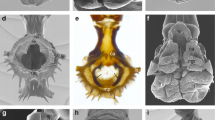Summary
-
1.
Male germ cells ofPseudaulacaspis pentagona (TARG.), an exceptional species of the coccid subfamilyDiaspinae, contain only approximately half as much DNA (measured by Feulgen cytophotometry) as do those ofChrysomphalus ficus Ash. — a typical representative of the group.
-
2.
Reversing this relationship, the chromosomes ofP. pentagona number 16 in the female, 8 in the male — whileC. ficus has the basic complement of the subfamily, numbering 8 in the female, 4 in the male (Brown andBentsnett 1957).
-
3.
The total mass of the chromosomes in the 2 complements is roughly proportional to the DNA values. It is concluded that 2 downward shifts in the level of chromosomal polyteny have been associated with the doubling of the chromosome number inPseudaulacaspis pentagona.
-
4.
The cytology of the diaspines is discussed in relation to the evolutionary origin of male haploidy in coccids.
Similar content being viewed by others
References cited
Ansley, H. R.: A cytologioal and cytophotometric study of alternative pathways of meiosis in the house centipede (Scutigera forceps Rafinesque). Chromosoma6, 656–695 (1954).
Brown, S. W., andF. D. Bennett: On sex determination in the diaspine scalePseudaulacaspis pentagona Tarq. (Coccidae). Genetics42, 510–523 (1957).
Hughes-Schrader, S.: A new type of spermiogenesis in iceryine coccids, with linear alignment of chromosomes in the sperm. J. of Morph.78, 43–84 (1946).
—: Cytology of coccids (Coccoïdea-Homoptera). Adv.Genet.2, 127–203 (1948).
—: The chromosomes of the giant scaleAspidoproctus maximus Louns. (Coccoïdea-Margarodidae). Chromosoma7, 420–438 (1955).
Hughes-Schrader, S., andF. Schrader: Polyteny as a factor in the chromosomal evolution of thePentatomini (Hemiptera). Chromosoma8, 135–151 (1956).
Lindner, G.: Zur Zytologie vonAspidiotus perniciosus Comst. (Homoptera-Coccidae). Biol. Zbl.73, 456–458 (1954).
O'brien, R.: Deoxyribose nucleic acid in a haploid-diploid species (Steatococcus tuberculatus Morrison). Chromosoma8, 229–259 (1956).
Schrader, F.: The origin of mycetocytes inPseudococcus. Biol. Bull.45, 279–300 (1923).
—: Experimental and cytological investigations of the life-cycle ofGossyparia spuria (Coccidae) and their bearing on the problem of haploidy in males. Z. wiss. Zool.134, 149–179 (1929).
—: The chromosome cycle ofProtortonia primitiva (Coccidae) and a consideration of the meiotic division apparatus in the male. Z. wiss. Zool.138, 386–408 (1931).
Schrader, F., andS. Hughes-Schrader: Haploidy inIcerya purchasi. Z. wiss. Zool.128, 182–200 (1926).
—: Haploidy inMetazoa. Quart. Rev. Biol.6, 411–438 (1931).
—: Polyploidy and fragmentation in the chromosomal evolution of various species ofThyanta (Hemiptera). Chromosoma7, 469–496 (1956).
Author information
Authors and Affiliations
Additional information
This investigation was supported in part by grant RG-4370 from the U.S. Public Health Service.
Rights and permissions
About this article
Cite this article
Hughes-Schrader, S. Differential polyteny and polyploidy in diaspine coccids (Homoptera: Coccoidea). Chromosoma 8, 709–718 (1956). https://doi.org/10.1007/BF01259529
Received:
Issue Date:
DOI: https://doi.org/10.1007/BF01259529




